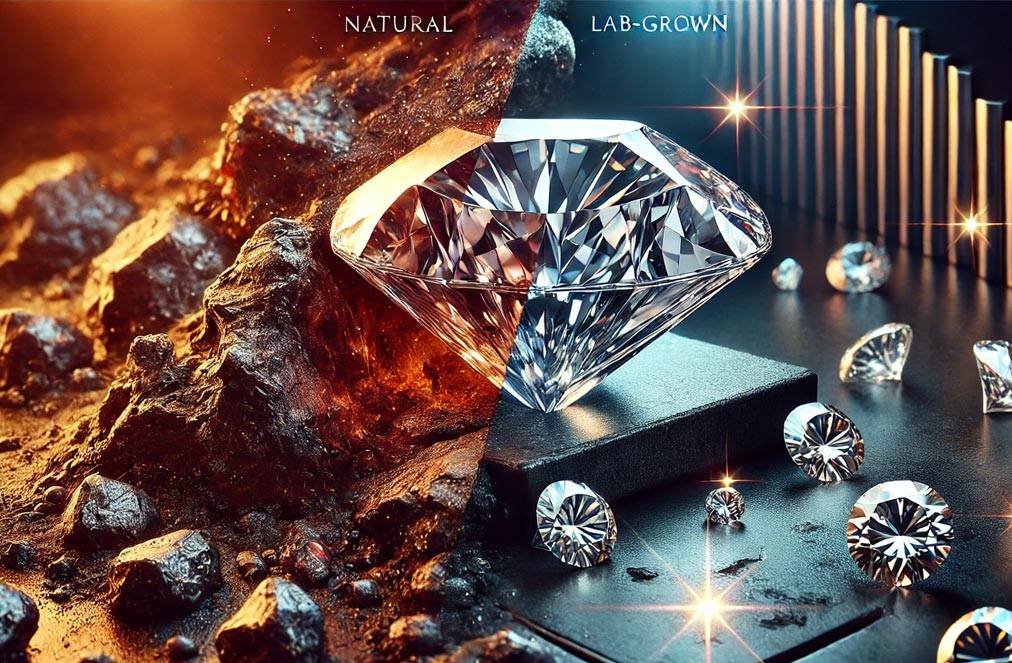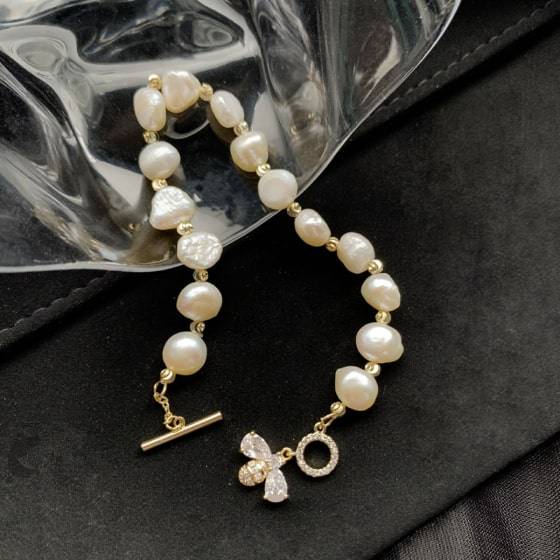Natural vs. Lab Grown Diamonds: What’s the Difference?

When it comes to choosing the perfect diamond, understanding the differences between natural and lab-created diamonds is essential. Both types of diamonds boast incredible beauty and brilliance, but their origins and price points vary significantly. This guide will provide you with a comprehensive comparison, helping you make an informed decision that aligns with your values and preferences.
Table of Contents
What Are Natural Diamonds?

Natural diamonds are formed deep within the Earth’s mantle under extreme heat and pressure. Over millions, sometimes billions, of years, carbon atoms bond together to create the unique crystalline structure that defines a diamond. This natural process, which occurs around 100 miles beneath the Earth’s surface, is nothing short of a geological marvel.
These diamonds are typically mined and then cut, polished, and graded by experts at gemological institutes such as the Gemological Institute of America (GIA). The GIA grades diamonds based on the 4Cs: Cut, Color, Clarity, and Carat weight, ensuring that buyers receive high-quality, authenticated gems.
What Are Lab Grown Diamonds?

Lab grown diamonds, also known as synthetic or man-made diamonds, are grown in controlled laboratory environments using advanced technological processes. These processes mimic the natural formation of diamonds within the Earth’s mantle, albeit at a much faster rate. The two primary methods used to create lab diamonds are High Pressure High Temperature (HPHT) and Chemical Vapor Deposition (CVD).
- HPHT Method: This method replicates the high-pressure, high-temperature conditions found deep within the Earth, transforming carbon into diamonds.
- CVD Method: In this method, carbon-rich gases are broken down, allowing carbon atoms to accumulate on a substrate and form a diamond crystal.
Despite being grown in a lab, these diamonds are chemically, physically, and optically identical to their natural counterparts. Like natural diamonds, lab diamonds are also graded by reputable organizations such as GIA or IGI (International Gemological Institute), providing the same assurances of quality.
The Big Debate: Natural vs. Lab Grown Diamonds

Price Comparison
One of the most noticeable differences between natural and lab grown diamonds is price. Natural diamonds command higher prices due to their rarity and the extensive mining process required to extract them. For instance, a natural diamond cross with GIA certification might cost around $22,000, whereas a comparable lab-created diamond cross could be priced at $5,500. This significant price difference makes lab diamonds an attractive option for those looking to maximize their budget without compromising on beauty.
Appearance and Quality
Visually, it’s nearly impossible to distinguish between natural and lab-created diamonds. Both types of diamonds offer the same brilliance, fire, and scintillation that have made diamonds the most coveted gemstones in the world. Even experienced jewelers may struggle to tell them apart without the aid of specialized equipment.
In terms of clarity and color, lab-created diamonds often provide higher quality at a lower cost. For example, you could purchase a high-clarity, VSF (Very Slightly Included) lab diamond for a fraction of the cost of a similar natural diamond. This makes lab diamonds an excellent choice for those seeking a flawless appearance at a more affordable price.
Ethical and Environmental Considerations

Natural diamond mining has long been associated with ethical and environmental concerns. Issues such as conflict diamonds—diamonds mined in war zones and sold to finance armed conflict—have cast a shadow over the industry. Although initiatives like the Kimberley Process have been implemented to ensure diamonds are ethically sourced, concerns remain.
Lab grown diamonds, by contrast, are conflict-free by nature. Since they are produced in a controlled environment, there is no risk of supporting unethical practices. Additionally, lab diamonds have a smaller environmental footprint, as they do not require the extensive mining operations that can disrupt ecosystems and lead to land degradation.
Investment Value
When considering diamonds as an investment, natural diamonds have historically held their value better over time due to their rarity. The inherent scarcity of natural diamonds contributes to their long-term value. However, with technological advancements and changing consumer preferences, lab-created diamonds are gaining popularity, which could influence their market value in the future.
From my perspective, lab diamonds represent the future of the diamond industry. As these gems become more mainstream, they are likely to outshine natural diamonds in terms of affordability and ethical appeal. In 10 to 20 years, I believe that lab diamonds will be widely accepted and appreciated for their quality and size, offering a compelling alternative to natural diamonds.
Practicality and Everyday Wear
Both natural and lab grown diamonds are incredibly durable, making them ideal for everyday wear. With a hardness rating of 10 on the Mohs scale, diamonds are the hardest natural material on Earth. This means that whether you choose a natural or a lab-created diamond, your jewelry will remain beautiful and resilient over time.
Lab grown diamonds also offer a practical advantage for those who enjoy variety in their jewelry collection. Given their lower cost, you can purchase multiple lab diamond pieces for the price of one natural diamond, allowing you to enjoy a diverse selection of sparkling accessories.
Frequently Asked Questions (FAQs)
Are lab-grown diamonds real diamonds?
Yes, lab-grown diamonds are real diamonds. They have the same physical, chemical, and optical properties as natural diamonds. The only difference is their origin. While natural diamonds are formed over billions of years under the Earth’s surface, lab-grown diamonds are created in a controlled laboratory environment. However, both types of diamonds are made of pure carbon and exhibit the same brilliance and hardness.
Are lab-grown diamonds worth anything?
Lab-grown diamonds hold significant value, but typically they are priced lower than natural diamonds of similar quality. Their value lies in their ethical sourcing, environmental benefits, and affordability. As the technology to produce lab-grown diamonds has improved, they have become an attractive option for consumers looking for high-quality diamonds at a more accessible price point. However, they may not appreciate in value over time in the same way that rare natural diamonds might.
What are the disadvantages of lab-grown diamonds?
While lab-grown diamonds offer many benefits, they do have a few disadvantages:
- Resale Value: Lab-grown diamonds generally have a lower resale value compared to natural diamonds. They are less likely to appreciate over time.
- Perception: Some people may perceive lab-grown diamonds as less “authentic” because they are man-made, despite being chemically identical to natural diamonds.
- Availability: While lab-grown diamonds are becoming more widely available, they may not have the same variety in terms of rarity and unique characteristics as natural diamonds.
- Environmental Impact: Although lab-grown diamonds are often marketed as eco-friendly, the production process still requires significant energy, which can have its own environmental impact if not managed responsibly.
Can a jeweler tell the difference between lab-grown diamonds?
Most jewelers cannot distinguish between lab-grown and natural diamonds with the naked eye or even with a standard jeweler’s loupe. Both types of diamonds look identical in terms of color, clarity, and cut. However, with advanced equipment like a diamond tester or by sending the diamond to a gemological laboratory for certification, a jeweler can determine whether a diamond is lab-grown or natural. Some lab-grown diamonds also have inscriptions or microscopic markers that indicate their origin.
Final Verdict: Which Should You Choose?
The choice between natural and lab grown diamonds ultimately depends on your personal values and priorities.
- If you value tradition, rarity, and long-term investment, and are willing to pay a premium, a natural diamond may be the right choice for you. Natural diamonds have a timeless allure and are often seen as valuable heirlooms to be passed down through generations.
- If you’re seeking an affordable, ethically sourced, and eco-friendly option, lab-created diamonds are an excellent alternative. They offer the same stunning beauty as natural diamonds at a fraction of the cost, making them accessible to a broader audience without compromising on quality.
Conclusion: The Future of Diamonds
As we move further into the 21st century, lab-created diamonds are poised to become the dominant choice for consumers. The advancements in diamond-growing technology have made it possible to create diamonds that are virtually indistinguishable from natural ones, both in appearance and quality. Moreover, the lower cost and ethical benefits of lab diamonds make them an appealing option for today’s conscientious consumer.
Whether you’re buying a diamond for a special occasion, an engagement ring, or as an investment, it’s important to weigh the pros and cons of both natural and lab-created diamonds. Armed with the right information, you can make a decision that aligns with your values and meets your expectations, ensuring that your purchase is a source of joy for years to come.
All right’s reserved @ 2024 Jwlraddicts.com




















